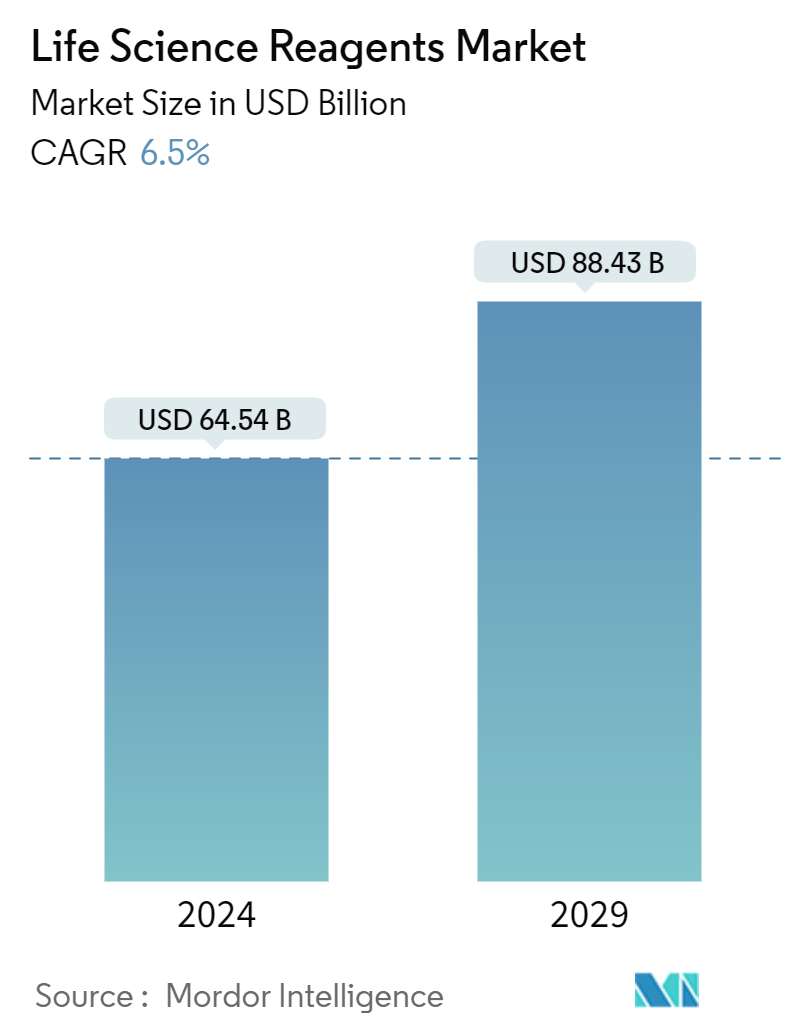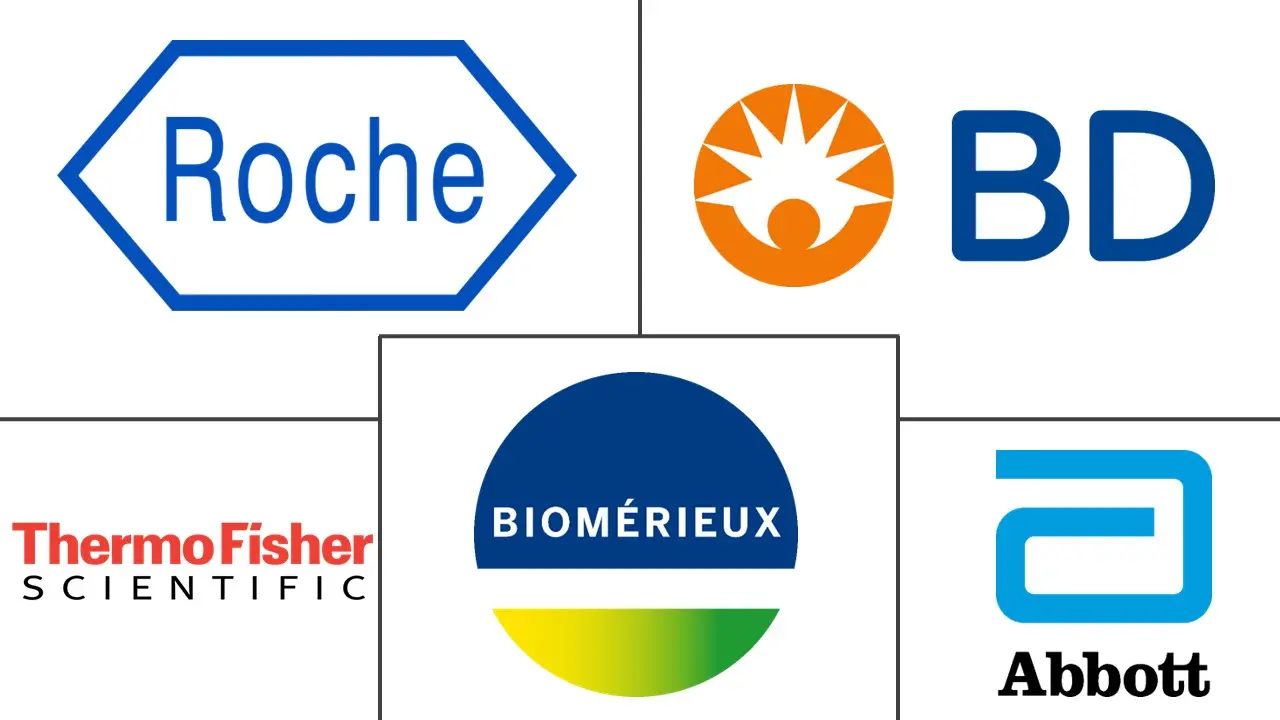Market Size of Life Science Reagents Industry

| Study Period | 2019 - 2029 |
| Market Size (2024) | USD 64.54 Billion |
| Market Size (2029) | USD 88.43 Billion |
| CAGR (2024 - 2029) | 6.50 % |
| Fastest Growing Market | Asia Pacific |
| Largest Market | North America |
| Market Concentration | Low |
Major Players
*Disclaimer: Major Players sorted in no particular order |
Life Science Reagents Market Analysis
The Life Science Reagents Market size is estimated at USD 64.54 billion in 2024, and is expected to reach USD 88.43 billion by 2029, growing at a CAGR of 6.5% during the forecast period (2024-2029).
During the COVID-19 pandemic, there was a rising demand for life science reagents, which pushed the growth of the life science reagents market during the period studied. COVID-19 is an infectious disease, the infection rate of which had risen exponentially worldwide. The rising number of COVID-19 cases increased the demand for tests and several types of research requiring reagents, propelling the market studied toward growth. For instance, in April 2021, Labcorp launched Pixel by Labcorp's COVID-19 PCR Test Home Collection Kit for small businesses, an initiative aimed at providing fast, convenient, and reliable testing for companies. Furthermore, due to the wide use of various agents in vaccine research and development, the market studied is expected to show growth during the forecast period.
Factors driving market growth include the high prevalence of infectious diseases and technological advancements in life sciences and biotechnology. Pathogenic microorganisms, such as bacteria, parasites, and viruses, are responsible for the high prevalence of infectious diseases. These diseases can be spread directly or indirectly from one person to another. They are highly transmittable and can quickly spread if preventive measures are not taken. The lack of healthcare structure and facilities can make these diseases fatal, which is the case in many developing and underdeveloped countries.
According to an article published by the Center for Disease Control and Prevention (CDC) in February 2022, Salmonella bacteria causes about 1.35 million infections, 26,500 hospitalizations, and 420 deaths in the United States every year. A high number of infectious diseases every year creates a burden on the healthcare system in the country. Therefore, there is an unprecedented increase in the demand for diagnostic reagents, boosting the market studied. Similarly, increasing incidence of chronic disorders are expected to increase the market growth. For instance, according to the October 2022 update of the World Health Organization, the incidence of tuberculosis (TB) was estimated to be around 10.6 million people in 2021, globally, of which 1.2 million were children. Similarly, a research study published in April 2022, in the National Library of Medicine stated that allergic rhinitis represents a significant health concern and affects about 400 million people, globally. Also, as per the same source, the prevalence of allergic rhinitis has increased over the years due to rising urbanization and pollution. It is further expected to increase over the years and boost the demand for life science reagents during the forecast period.
However, the high cost associated with reagents and the stringent regulatory framework act as barriers to market growth.
Life Science Reagents Industry Segmentation
As per the scope of the report, a reagent is a compound or mixture added to a system to occur a chemical reaction or a test if a reaction occurs. Life science reagents play a key role in cell-based products, manufacturing and testing pharmaceutical drug products, and several other healthcare-related solutions.
The Life Science Reagents Market is Segmented by Product Type (Cell and Tissue Culture Reagents, Chromatography Reagents, Clinical Chemistry Reagents, Immunoassay Reagents, Molecular Diagnostic Reagents, Microbiology Reagents, Other Product Types), End User (Hospitals and Diagnostic Laboratories, Academic and Research Institutes, Other End Users), and Geography (North America, Europe, Asia-Pacific, Middle East and Africa, South America). The market report also covers the estimated market sizes and trends for 17 different countries across major regions globally. The report offers the market sizes and forecasts in terms of value in USD million for the above segments.
| By Poduct Type | |
| Cell and Tissue Culture Reagents | |
| Chromatography Reagents | |
| Clinical Chemistry Reagents | |
| Immunoassay Reagents | |
| Molecular Diagnostic Reagents | |
| Microbiology Reagents | |
| Other Product Types |
| By End User | |
| Hospitals and Diagnostic Laboratories | |
| Academic and Research Institutes | |
| Other End Users |
| By Geography | ||||||||
| ||||||||
| ||||||||
| ||||||||
| ||||||||
|
Life Science Reagents Market Size Summary
The life science reagents market is poised for significant growth, driven by the increasing demand for diagnostic and research applications. The market's expansion is largely attributed to the heightened need for reagents during the COVID-19 pandemic, which underscored their critical role in testing and vaccine development. The prevalence of infectious diseases and chronic disorders, coupled with technological advancements in biotechnology, are key factors propelling market growth. The demand for life science reagents is further bolstered by the rising incidence of diseases such as cancer and tuberculosis, which necessitate robust diagnostic solutions. Despite the high costs and regulatory challenges associated with reagents, the market continues to thrive, supported by strategic initiatives from major players and the growing adoption of molecular point-of-care testing.
North America is expected to maintain a dominant position in the global life science reagents market, driven by a significant geriatric population and a high incidence of chronic and infectious diseases. The region's healthcare infrastructure and ongoing research and development activities contribute to its market leadership. The competitive landscape is characterized by the presence of several major players, including Hoffmann-La Roche, Thermo Fisher Scientific, and Abbott, who are actively engaged in product launches, partnerships, and acquisitions to enhance their market offerings. These strategic moves, along with the introduction of innovative products like in-vivo RNA transfection kits, are anticipated to further stimulate market growth during the forecast period.
Life Science Reagents Market Size - Table of Contents
-
1. MARKET DYNAMICS
-
1.1 Market Overview
-
1.2 Market Drivers
-
1.2.1 High Burden of Infectious Diseases
-
1.2.2 Technological Advancements in the Field of Life Sciences and Biotechnology
-
-
1.3 Market Restraints
-
1.3.1 High Cost of Reagents
-
1.3.2 Stringent Regulatory Framework
-
-
1.4 Porter's Five Force Analysis
-
1.4.1 Threat of New Entrants
-
1.4.2 Bargaining Power of Buyers/Consumers
-
1.4.3 Bargaining Power of Suppliers
-
1.4.4 Threat of Substitute Products
-
1.4.5 Intensity of Competitive Rivalry
-
-
-
2. MARKET SEGMENTATION (Market Size by Value - in USD Million)
-
2.1 By Poduct Type
-
2.1.1 Cell and Tissue Culture Reagents
-
2.1.2 Chromatography Reagents
-
2.1.3 Clinical Chemistry Reagents
-
2.1.4 Immunoassay Reagents
-
2.1.5 Molecular Diagnostic Reagents
-
2.1.6 Microbiology Reagents
-
2.1.7 Other Product Types
-
-
2.2 By End User
-
2.2.1 Hospitals and Diagnostic Laboratories
-
2.2.2 Academic and Research Institutes
-
2.2.3 Other End Users
-
-
2.3 By Geography
-
2.3.1 North America
-
2.3.1.1 United States
-
2.3.1.2 Canada
-
2.3.1.3 Mexico
-
-
2.3.2 Europe
-
2.3.2.1 Germany
-
2.3.2.2 United Kingdom
-
2.3.2.3 France
-
2.3.2.4 Italy
-
2.3.2.5 Spain
-
2.3.2.6 Rest of Europe
-
-
2.3.3 Asia-Pacific
-
2.3.3.1 China
-
2.3.3.2 Japan
-
2.3.3.3 India
-
2.3.3.4 Australia
-
2.3.3.5 South Korea
-
2.3.3.6 Rest of Asia-Pacific
-
-
2.3.4 Middle East and Africa
-
2.3.4.1 GCC
-
2.3.4.2 South Africa
-
2.3.4.3 Rest of Middle East and Africa
-
-
2.3.5 South America
-
2.3.5.1 Brazil
-
2.3.5.2 Argentina
-
2.3.5.3 Rest of South America
-
-
-
Life Science Reagents Market Size FAQs
How big is the Life Science Reagents Market?
The Life Science Reagents Market size is expected to reach USD 64.54 billion in 2024 and grow at a CAGR of 6.5% to reach USD 88.43 billion by 2029.
What is the current Life Science Reagents Market size?
In 2024, the Life Science Reagents Market size is expected to reach USD 64.54 billion.

